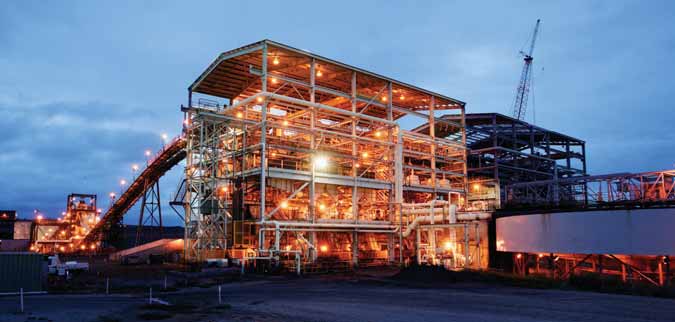Australia has an abundant supply of
mineral resources. The country also has
some challenges with complex deposits
in remote locations and the associated
logistical requirements of getting those
resources to market. Combine those
issues with a shortage of skilled professionals
to operate the mines, and one
has an accurate understanding of the
Australian mining market. But, even in
the face of those challenges, the country
remains a leader and it manages to
export its services and expertise abroad.
When faced with tough challenges,
Aussies use innovation to get the job
done and to do more with less in ways
that haven’t been done before. A lot of
that innovation stems from technology.
Similar to many industries, mining is
experiencing a fundamental drain on
technical resources. The universities
have not churned out enough mining
engineers and metallurgists, and with
the rising markets, that lack of resources
is having a compounding effect.
To gauge the current state of affairs
in Australia, E&MJ spoke to four Australian
firms: Byrnecut Mining, Runge,
Immersive Technologies, and Sedgman.
All of them are naturally looking to grow
their book of business. Byrnecut is an
engineering and production contractor
with clients that have complex underground
mining scenarios. Runge deals
in both surface and underground mining
and it has a collection of software that it
is exporting to the world. Immersive
Technologies developed the first
advanced simulator for the mining business,
and it is growing faster than ever
with more features. Lastly, Sedgman
talked about growing a company from a
coal-only business to one that knows
mineral processing abroad.
Byrnecut Mining Does More with Less
The labor market environment in
Australia has eliminated bureaucratic
layers of management in successful
companies, explained Steve Coughlan,
managing director, Byrnecut Mining.
The lack of people has made companies
more efficient, particularly in the case
of mining contractors who have long
driven the competitive edge of the
value/cost equation. “This environment
has resulted in real alliance contracts
whereby duplication of roles has been
eliminated and sensible analysis of risk
has been undertaken to determine
which party is best equipped to deal
with the risk,” Coughlan said. “In an
open forum with all alliance members
on the same page, enthusiasm and productivity
thrive providing there is still a
hard edge based on key performance
indicators. From a contractor’s perspective,
the market has evolved where long
term contracts are common allowing
investment in modern equipment and
substantial systems in areas of training,
OH&S and maintenance. We would
argue, in many cases, better than many
mining companies.”
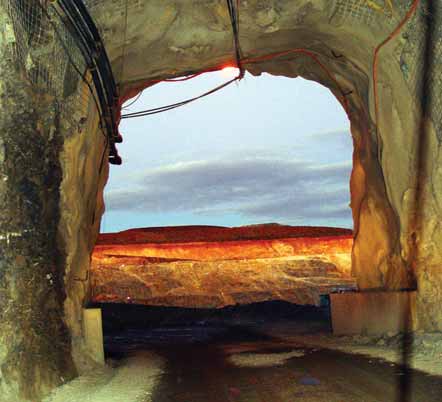 Byrnecut Mining specializes in underground mining and it
sees a lot of potential for
Byrnecut Mining specializes in underground mining and it
sees a lot of potential for
improvement within the industry.
The issue of labor skills across the
board from professionals to operational
staff will continue to be a problem. “In
Australia, it’s hard to see how we can
provide that without increasing skilled
immigration—there are just not enough people,” Coughlan said. “There
is competition
from other industries and
lifestyle issues that also need to be
countered. Not everyone wants to work
in mining camps, regardless of the
money. A greater emphasis needs to be
placed on females in the workforce as a
source of labor.”
Byrnecut Mining is purely an underground
contractor. “Complexity of
deposits is not an issue,” said
Coughlan. “In our view, it comes down
to economics. We see a long-term role
for contractors in providing significant
productivity skills and capability to a
range of companies regardless of the
size of the company or the deposit.
There is no question Australian underground
productivity and costs are driven
by competition between contractors.”
Byrnecut Mining exports its skills
internationally. “We now work in
Europe, Indonesia, New Zealand,
Central Asia and Africa in addition to
Australia,” Coughlan said. “The benefits
we offer are immediate first world
productivity and systems that would
take generations to develop in third
world countries. Our challenge is to
transfer those skills to various national
employees working for us in those countries
as, one, Australian expatriate labor
is expensive and, two, we would like to
use those nationals in our global workforce
outside their country of residence.”
Byrnecut’s strength is its core of
long-term employees and the intrinsic
knowledge that they bring to a project.
“You just cannot buy that off the shelf,”
Coughlan said. “Similarly, systems and
procedures have been honed over more
than a generation in the Australian mining
environment, which demands a
strong safety culture, and a competitive
“can do” innovative work ethic. Byrnecut
Mining, and Australian business in
general, is rightly perceived as being
very straight, i.e. they do not tolerate
any corruption, wherever they work.”
Underground mining is a tough business
and Byrnecut Mining has steadily
improved safety performance over a
long period of time by developing systems
that concentrate on leading indicators
(as opposed to lagging statistics).
“If you concentrate on compliance
with quality systems, training and
procedures, and give ownership to the
workforce, safety and productivity will
follow,” Coughlan said. “Our Lost Time
Injury rate is around 2.5 per million
man-hours worked and we can do better
than that. There are no quick fixes but
you must be prepared to go the long
road and invest in the people and systems
to get there.”
Some of Byrnecut Mining’s recent
accomplishments include:
• The introduction of a Sandvik Tamrock
T08 tunneling drill jumbo with
TCAD and incycle hydroscaling and
fibrecrete at Prospero decline for
Jubilee nickel in WA. This resulted
in +5.5-m rounds to rapidly develop
a single heading 1:7 decline.
• The introduction of a MINEGEM
auto-remote loader in a narrow vein
operation at the Jundee gold mine in
alliance with Newmont. Productivity
improvement and reduction in
loader damage have been very
encouraging.
• Successive world records for development
jumbo-drilled meter performance
have been achieved at several
sites including Jundee (Newmont),
Telfer (Newcrest) and Nifty
copper mine (Birla). The current
world record was achieved at Nifty
where one jumbo completed 63,726
drilled meters during the 30 days of
June 2007.
Runge Integrates Operations with Mine Planning
Necessity is the mother of invention.
“In the days gone by, once a mine confirmed
a resource, it was on the downhill
run,” said Pat Williams, general
manager-strategic development, Runge
Mining. “That’s the start of the marathon
today. Bringing the operations to
fruition and then operating them with
reliable consistent modern discipline is
a constant challenge.”
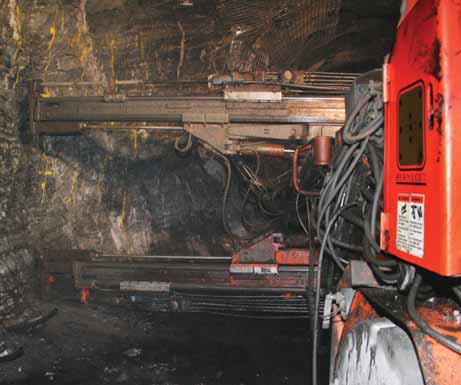 Byrnecut Mining introduced a T08 tunneling jumbo drill to
increase development rates at
Byrnecut Mining introduced a T08 tunneling jumbo drill to
increase development rates at
Jubilee’s Prospero decline.
“Mining companies have either
found or are operating good large deposits,” said Williams. “They
have
consolidated them and they have those
sorts of efficiencies. They have maximized
the equipment sizes and all of
the physical assets. The remaining
nuggets of value to be converted are
operating excellence—knowing and getting
a closer feedback loop in the workflow
as to: what should be there, how
we should get it, what’s required to get
it, and getting it, so that the show can
be kept on the road.”
What Williams is talking about is
complete integration of operations
planning and delivery of the product.
“Mines need to use technology and systems
to support the operation in a very
connected way,” said Williams. “The
mining company doesn’t need a bunch
of isolated scientists [geologists, engineers,
etc.] working in a back room,
while the crusty operations types run
the mine. There is an identified value to
having those two worlds joined together–
and it’s being expressed at serious
levels within mining corporations. We
need to bring the planning, the technology
and the science into the operation.
There often has been a disjoint
between the planning and design stage
vs. the execution of mining operations.
The challenge is to operate with discipline,
efficiency and certainty but
please no surprises.”
The position or footprint that Runge
fills, according to Williams, is 1-in. wide
and 25 miles deep. “Runge is that keystone
between the world of science,
engineering and geology, and the operation
of the mine,” Williams said. “We
join two worlds together by providing,
not just software and technology systems,
but the sustainable processes that
put them in place. We translate the
technical data—tons, grade, and all of
the physicals—into an executable business
plan and do it in such away where
the operators at the mine can execute
with a very valid road map in front of
them.” Williams explained that Runge’s
role is not just to develop some software
for the mines and hopefully they like it
and want more. He said it’s the stewardship
of bringing sustainable technology
systems into the mine in that particular
niche that joins those two worlds.
Runge works with all commodities
and mining methods from the biggest
underground metalliferous mines to the
largest open-pit mines. “We do everything,”
Williams said. “There’s no exclusion.
Where there is complexity and
non-intuitive requirements, that’s
where we work well.”
Mining companies can’t fill the
vacancies, so now the remaining people
have to do more with less. “That’s driving
the efficiencies of what people do,”
Williams said. “Once upon a time, engineers
had a large degree of autonomy in
the technical world. People could come
in and create their own ‘patch’ to solve
problems, but there is a strong business
requirement for standard processes
because people come and go. Mining
companies can no longer afford the
inefficiencies of having to relearn. This
is not just a quality assurance drive.
These are sustainable dynamic business
processes that transcend the people
in the chair and allow the business
to move forward independent of who’s
behind the wheel.”
In Australia, there is a lot of creativity
today. “The owner-operated, fullyemployed
workforce is almost a thing of
the past,” Williams said. “A variety of outsourced
involvement, not just contractors,
is being offered and orchestrated through
a single point of contact. Runge has a
variety of people that are not necessarily
on the payroll, but provide their service to
the mining customer as part of one so
there’s only one neck to strangle if there’s
a problem.”
Runge has been around for about 30
years and has 15 offices in different
parts of the world. “We own and operate
all of them,” Williams said. “Runge does
not work through distributors, agents, or
resellers. The length of time it took for
the company to grow from one to three
offices was almost 18 years, and the
jump from three to 15 has taken less
than 10 years. And, all of the last 10
offices have been outside Australia.”
Emerging markets, such as China
and Eastern Europe [Russia particularly]
and India to a lesser extent, do not want
to reinvent the wheel. “These companies
are broad minded and global thinking,”
Williams said. “If Australians have
cut their teeth on this, the emerging markets are driven by picking up on the
gains that others have made. They don’t
want to take the same baby steps. In the
last year, Runge has opened offices in
Beijing and Indonesia. Those markets
want to get into the game at the current
level of understanding.”
Runge uses acquisitions to retain
talent. “In the last six months we have
added two companies,” Williams said.
“We are acquiring another in very short
order. They are either domain experts
(more engineers, geologists, operations)
or it’s technology.” Williams believes
that mines want on-site service by firms
with broad experience rather than companies
that have grown up serving a few
mines in the region.
Williams explains that Runge has
more than a global footprint; it has
global consistency. “The name Runge
means the same thing in Russia as it
does in Brazil,” Williams said. “That’s
kind of unique. And, that’s something
our customers regard highly. Our customers
do not want surprises. We are
not trying to be all things to all people.
“There’s a big requirement in the
mining industry to join the operations to
the business of the rest of the enterprise,”
Williams said. “What happens in
the mining operation is industry-specific.
There is no manufacturing or bulk
commodity model that applies to what
mining companies do. We understand
that and we service it with a combination
of relevant technology and people that
can back it up. We use domain specialists
with practical experience that put
themselves in the job to get it done.”
With every acquisition, there is a bidirectional
exchange, according to
Williams. Prior to the acquisition, there
has to be a cultural fit. “That is a strictly
scrutinized part of selecting an
acquisition target,” Williams said. “In
addition to an operational fit, the
assessment criteria determine whether
we see life the same way and can work
together. Our acquisitions keep the
brands. They have invested a lot of time
and money in those brands. Basically,
we are a brand aggregator.
“Knowing that the acquired firms
have strength, history and a reputation
in a particular space, we place a lot
effort going into common back office
systems and common infrastructure,”
said Williams. “The process really is a
synthesis rather than a concentrated
indoctrination. The hard work starts
after the deal is worked to make sure
that we integrate with effectiveness.”
Immersive Unlocks Money from Inefficiencies
Immersive Technologies began producing
computer-based training systems
for the mining industry in 1993. In
1995, the company made a significant
commitment to a mining simulator
research-and-development program. In
1997, working with Westrac (a Western
Australia Caterpillar dealer), it developed
the first commercial haul truck
simulator for the mining industry. Cat
purchased that unit in 1998. Since
that period the company has experienced
a phenomenal growth rate.
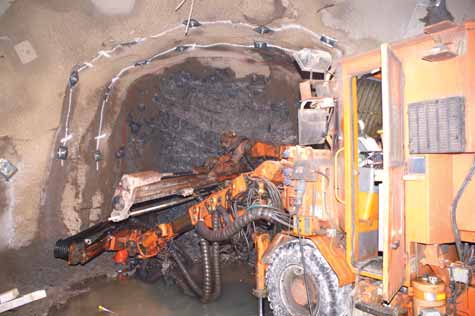 Byrnecut Mining has set successive world records for developments with jumbos.
Byrnecut Mining has set successive world records for developments with jumbos.
The company has established strategic
working alliances with the leading
original equipment manufacturers
(OEMs) to ensure a high level of realism
and accuracy. Immersive Technologies
offers simulators for six machines
classes: haul trucks, excavators, shovels,
dozers, wheel loaders, and draglines. More than 55 different mining
machines can be simulated, with new
models currently in development.
Today, Immersive Technologies’ Advanced
Equipment Simulators are in
use around the world and have trained
and assessed thousands of personnel.
Multi-national mining companies,
equipment manufacturers and dealers,
and training schools use the simulators
in their operator training programs.
“This particular technology is an
excellent—maybe the best ever—facilitator
of workforce development,” said
Steve Altman, vice president-North
America, Immersive Technologies.
“There are a lot of inefficiencies in
mining. These inefficiencies are born
out of non-optimal use of equipment.
Similar to most initiatives based on
human resources, the subjectivity and
the expense that’s traditionally required
to tap into that pool of money which
will be borne out of higher efficiencies,
was cost prohibitive. Managers didn’t
have enough objective information to
invest on a quarterly basis in those
human resources initiatives.”
The simulator brings objectivity to
skill levels and operator performance that
wasn’t possible before. It does it in a very
automated and efficient way. Once those
assessments are made, the users have
the ability to modify operator behavior.
“It’s really a business improvement tool
regarding the performance of operators,”
said Altman. “The potential impact for
those using it correctly is huge.”
Technology has improved with time
and so have the simulators. The most
significant changes have been the progression
of computing speed, graphics,
and interrupt rates. Those improvements
allow a smoother type of simulation.
“The realism that we can put into
the simulation continues to increase,”
said Altman. “Based on a software
business model, every six months
Immersive Technologies issues a new
software release. That allows us to
incrementally improve the units in the
field. Even the ones that we sold first
are upgradable and ongoing.”
The largest advancements in relating
value to the end-user is the company’s
understanding of best practices in
mining and it has translated that understanding
into specific features for the
simulators. Immersive Technologies
now has more than 100 simulators
commissioned worldwide and it has
access to all of those users. “One of the
luxuries that we enjoy is a 90% to 95%
marketshare in above ground simulators
in mining,” Altman said. “Through our
user group forum, which takes place
every 18 months, and continuous feedback
through customer services, our
sales staff, and ongoing contact with
our customers, we polled best practices
to help guide the industry in general as
to how this technology can have the
biggest impact on the bottom line.”
That understanding of the business
intelligence around how to use the technology
is an area where the company
sees a lot more potential for the mining
business. “We refer to these tools as
Business Intelligence and it is an important
part of Immersive’s Value Proposition
being built into the simulators,”
Altman said. “It’s a new feature that
incorporates business reporting and cost
accounting.”
In the future, users will see more
automation. Altman draws parallels to
PCs, where the first applications were
extremely rudimentary and so much had
to been done with coding and programming.
As an example, when running a
training program, there are many different
training objectives from prescreening
of equipment operators to continuous
improvement to U.S. Mine Safety
and Health Administration (MSHA)
yearly refreshers. Many of those repetitive
tasks such as government reporting
could be automated.
What mining companies like most
about the simulators are the uses in training
endeavors, such as new hires and adhoc
training. A prime example of ad-hoc
training would be a program to retrain
operators for excessive brake usage or
reaction to critical events such as a major
systems failure (brakes, fire from a turbo,
blown tire, etc.). More advanced uses
revolve around analysis and assessment.
“When a driver is placed in a high fidelity
simulated circuit in a custom mine site
and allowed to drive, the simulator
records the areas where the operator is deficient,” Altman said. “The
overall goal would be to tighten up
standard deviations on the cycle times. They are a little more
laborious to achieve and it takes a more organized effort on the
users’ part, but some users are endeavoring to do that and we
are waiting on the official results.”
Like any other technology, these simulators are enablers.
Operating efficiency is predicated on good behavior. This particular
technology will enable a regimented continuous
improvement approach that’s documentable and reportable—
something that management can act on.
Sedgman Acquires Intermet, Looks for Outsourcing Opportunities
Sedgman Limited is transitioning from an Australian coal-only
player to a leading provider of engineering services to the global
resources industry. The company, established in 1979, listed
on the Australian Stock Exchange in June 2006 and has been
expanding steadily into the metalliferous sector since.
Recognized internationally for its engineering design, construction
and operation of coal handling and preparation plants
(CHPPs), the company entered the metals market in December
2006 by purchasing, for A$65 million, Pac-Rim, an ore crushing
and screening services provider. In July, Sedgman acquired
Intermet, a minerals process engineering and project management
company based in Perth, for A$32.75 million.
The Intermet acquisition allows Sedgman to further
expand into mineral processing and to grow outside of
Australia. The company now has a presence in Western
Australia with a firm that has metals project delivery experience
in both Australia and overseas. “This is an excellent fit
for Sedgman’s existing business, especially as far as shared
resources,” said Peter Hay, managing director, Sedgman.
“The Intermet acquisition brings increased operations service
opportunities and synergies with Pac-Rim.”
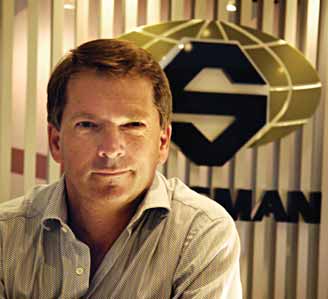 Peter Hay, managing director, Sedgman Limited.
Peter Hay, managing director, Sedgman Limited.
Intermet’s core capabilities consisted of metallurgical test
works, process development and design, feasibility studies,
engineering design and costing, and project evaluation.
Approximately 85% of Intermet’s revenues were sourced from
EPCM-style contracts and it employed 80 people.
What excites Hay the most about the acquisition is the
technical competence of the Intermet crew. “Sedgman’s
coal business is based on its technical excellence and
Intermet had that same core capability,” he said. “Over a
period of time we have developed a system that we believe
can leverage the Intermet expertise. The group had a strategic
presence in Western Australia. It was in the metals sector,
which is an area we are trying to grow, and it had the
international experience.”
When Sedgman scouts for acquisitions, explained Alan
Wigan, CFO, Sedgman, it looks for niche players that have
the technical expertise. Essentially it looks for other companies
that have what it has. The company gets exposed to
their level of professionalism and skills. “Recently, there has
been an enormous drain on our engineering capabilities
especially during this current boom in commodity prices and the minerals cycle,”
said Wigan.
“There’s a lot of competition to get
skilled people.”
Cross-pollination between the coal
and mineral guys is part of the opportunity
in terms of attracting people
with broad skills. “There are people
that like to see that, in terms of career
opportunities, we will be encouraging
that and it will also ensure that we get
the appropriate utilization of our
resources. In terms of demand, it
might change from time to time from
one sector to the other,” Hay said.
The recent acquisitions give Sedgman
the opportunity to do in metals
what it has done in coal where it is recognized
internationally in terms of coal
preparation expertise. “That expertise
has been developed because of the
relationship between our engineering
services and our operations, and the
feedback we get from being a plant
operator,” Hay said. “That model is
what we are seeking to emulate in the
metals industry. With the expertise and
niche skills available to us through
Intermet, we have the opportunity to do
that again.”
Ideally, Sedgman would like to run
the CHPP. “It depends of the facility,
but a typical coal plant would have 20
to 30 people on site,” Hay said. “We
have about 100 people working in our
operations area in coal and we have
about the same within Pac-Rim on the
metals side. Organizationally, Sedgman
now stands at 550 people.”
“Most mining companies operate
their own mineral processing plants,”
Hay said. “That’s certainly an area
where we are trying to change the client
approach and offer an outsourcing service.
Coal has historically been like that.
We now have five operations. It’s probably
not unrelated to the access to skills
and resources. Having the skills and
resources makes Sedgman more attractive
to prospective clients.”
A prime example of how Sedgman
would like to see a deal structured is
the Middlemount contract that the
company recently signed. During June,
Sedgman signed a A$65 million contract
for the design and construction of
a CHPP at the Middlemount coal project
in Queensland, together with a 10-
year operations agreement. Hay said
the contracts were awarded to Sedgman
without a tender process and was
illustrative of Sedgman’s expertise and
reputation. “The planned 400 mt per
hour CHPP will process up to 2.9 million
mt per year of coking and thermal
coal. The 10-year operations contract
will bring the number of CHPPs which
Sedgman operates to five.”
The CHPP operations contract will
deliver recurring income over a 10-
year period, commencing in the 2009
financial year, following the commissioning
of the CHPP in 2008. “Sedgman’s
approach of working directly
with the client to identify their needs
ensures the seamless delivery of the
whole project, right through from
design to operations,” Hay said. The
Sonoma project is similar. Sedgman
has announced the first stage of that
project, which is the design and construction
of the CHPP. The company is
currently in negotiations for the operating
contract, but it expects it to be very
similar to the Middlemount contract.
“The recent acquisitions confirm
our strategy to grow the commodity
base outside of coal,” said Hay. The
company also wants to grow globally, in
terms of where it is providing services.
“In coal, that’s already starting. We are
working with CVRD in Mozambique on
the Moatize project. We are working
with existing clients in other parts of
the world. We are looking at opportunities
in India and China. Intermet is
already in Asia and Africa.”
The greatest challenge facing Sedgman
is people, according to Hay, and
it’s something the company really does
focus on organizationally in terms of
personal and professional development.
“The structures that we have
available to us now that we are listed
have provided us we flexibility as to
how we engaged them,” Hay said. “The
other major area that we focus on is
safety. In Australia, it’s very important,
but there are challenges as we diversify
internationally in terms of maintaining
that safety culture. Other things we
are pursuing are R&D activities. Some
of those are associated with sustainability
in terms of water recovery and
power efficiency. We are looking at
other technologies that will enhance
the utilization of the resources we are
exploiting. We are investing in our
future in that regard.”
